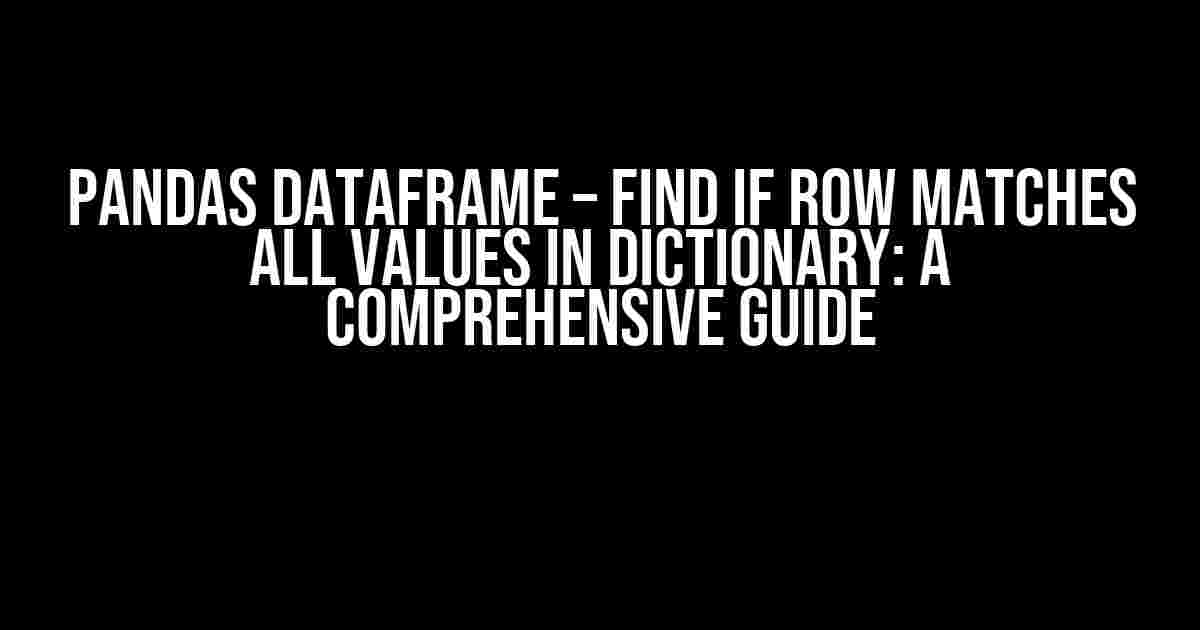Working with Pandas DataFrames can be a breeze, but sometimes, you need to get creative with your data manipulation. In this article, we’ll dive into the world of Pandas and explore how to find if a row matches all values in a dictionary. Yes, you read that right – we’re talking about a dictionary! But don’t worry, by the end of this tutorial, you’ll be a pro at using dictionaries to filter your DataFrames.
What is a Pandas DataFrame?
Before we dive into the juicy stuff, let’s quickly cover the basics. A Pandas DataFrame is a two-dimensional data structure that stores data in rows and columns. It’s similar to an Excel spreadsheet or a SQL table, but with more flexibility and power. DataFrames are the core data structure in Pandas, and they’re used to store and manipulate large datasets.
import pandas as pd
data = {'Name': ['John', 'Anna', 'Peter', 'Linda'],
'Age': [28, 24, 35, 32],
'Country': ['USA', 'UK', 'Australia', 'Germany']}
df = pd.DataFrame(data)
print(df)
Name Age Country
0 John 28 USA
1 Anna 24 UK
2 Peter 35 Australia
3 Linda 32 Germany
What is a Dictionary?
A dictionary, also known as a hash or an associative array, is a data structure that stores key-value pairs. In Python, dictionaries are defined using the `{}` syntax, and they’re used to store and manipulate data in a flexible and efficient way.
my_dict = {'Name': 'John', 'Age': 28, 'Country': 'USA'}
print(my_dict)
{'Name': 'John', 'Age': 28, 'Country': 'USA'}
The Problem: Finding Rows that Match a Dictionary
Now, let’s say we have a DataFrame with multiple rows and columns, and we want to find all the rows that match a specific dictionary. For example, we might want to find all the rows where the `Name` is ‘John’, the `Age` is 28, and the `Country` is ‘USA’. How do we do that?
Method 1: Using the `isin()` Method
One way to solve this problem is by using the `isin()` method, which checks if values are present in an iterable (like a list or a dictionary). We can create a boolean mask using `isin()` and then use it to filter our DataFrame.
import pandas as pd
data = {'Name': ['John', 'Anna', 'Peter', 'Linda'],
'Age': [28, 24, 35, 32],
'Country': ['USA', 'UK', 'Australia', 'Germany']}
df = pd.DataFrame(data)
my_dict = {'Name': 'John', 'Age': 28, 'Country': 'USA'}
mask = (df['Name'].isin([my_dict['Name']]) &
df['Age'].isin([my_dict['Age']]) &
df['Country'].isin([my_dict['Country']]))
result = df[mask]
print(result)
Name Age Country
0 John 28 USA
This method works, but it has one major limitation: it only works when the dictionary values are exact matches. What if we want to find rows that match a dictionary with partial matches? For example, what if we want to find all the rows where the `Name` starts with ‘J’ and the `Age` is greater than 25?
Method 2: Using the `apply()` Method with a Lambda Function
This is where the `apply()` method comes in. We can use `apply()` to apply a lambda function to each row of our DataFrame, and then use that function to check if the row matches our dictionary.
import pandas as pd
data = {'Name': ['John', 'Anna', 'Peter', 'Linda'],
'Age': [28, 24, 35, 32],
'Country': ['USA', 'UK', 'Australia', 'Germany']}
df = pd.DataFrame(data)
my_dict = {'Name': lambda x: x.startswith('J'), 'Age': lambda x: x > 25, 'Country': lambda x: x == 'USA'}
mask = df.apply(lambda row: all(my_dict[col](row[col]) for col in my_dict), axis=1)
result = df[mask]
print(result)
Name Age Country
0 John 28 USA
This method is more flexible and powerful, but it can be slower than the `isin()` method for large datasets.
Method 3: Using the `query()` Method
The `query()` method is another way to filter a DataFrame using a dictionary. We can pass a dictionary to the `query()` method, and it will return a new DataFrame with the rows that match the dictionary.
import pandas as pd
data = {'Name': ['John', 'Anna', 'Peter', 'Linda'],
'Age': [28, 24, 35, 32],
'Country': ['USA', 'UK', 'Australia', 'Germany']}
df = pd.DataFrame(data)
my_dict = {'Name': 'John', 'Age': 28, 'Country': 'USA'}
result = df.query(' and '.join(f'{col} == {value!r}' for col, value in my_dict.items()))
print(result)
Name Age Country
0 John 28 USA
The `query()` method is a concise and expressive way to filter a DataFrame, but it only works when the dictionary values are exact matches.
Conclusion
In this article, we’ve explored three methods for finding rows that match a dictionary in a Pandas DataFrame. Whether you’re using the `isin()` method, the `apply()` method with a lambda function, or the `query()` method, you now have the tools to filter your DataFrames with ease.
Remember to choose the method that best fits your specific use case, and don’t be afraid to get creative with your dictionaries and filtering logic. Happy coding!
| Method | Description | Pros | Cons |
|---|---|---|---|
| isin() | Uses the isin() method to check for exact matches | Fast and efficient | Limited to exact matches |
| apply() | Uses the apply() method with a lambda function to check for partial matches | Flexible and powerful | Slower than isin() for large datasets |
| query() | Uses the query() method to filter the DataFrame | Concise and expressive | Limited to exact matches |
Which method will you choose?
Frequently Asked Question
Get ready to dive into the world of Pandas DataFrames and learn how to find if a row matches all values in a dictionary!
How can I check if a row in a Pandas DataFrame matches all values in a dictionary?
You can use the `.loc` accessor and the `==` operator to compare the DataFrame with the dictionary. For example: `df.loc[(df[list(dict.keys())] == list(dict.values())).all(axis=1)]`. This will return all rows that match all values in the dictionary.
What if my dictionary has column names as keys, and I want to match the values exactly?
In that case, you can use the `.eq` method to compare the DataFrame with the dictionary. For example: `df[df.eq(d).all(axis=1)]`. This will return all rows where the values in the DataFrame match the values in the dictionary exactly.
How can I check if a row matches any value in a dictionary, not just all values?
You can use the `|` operator to perform an element-wise logical OR operation. For example: `df[(df[list(dict.keys())] == list(dict.values())).any(axis=1)]`. This will return all rows that match at least one value in the dictionary.
What if my dictionary has multiple values for each key, and I want to match any of them?
In that case, you can use the `isin` method to check if the values in the DataFrame are in the list of values in the dictionary. For example: `df[df.isin(d).any(axis=1)]`. This will return all rows that match at least one value in the dictionary.
Can I use this approach with a DataFrame that has multiple data types, such as strings and integers?
Yes, you can! The approach works with DataFrames that have multiple data types. Just make sure to adjust the comparison accordingly. For example, if you have a column with strings, you might need to use the `str.contains` method instead of `==`.



